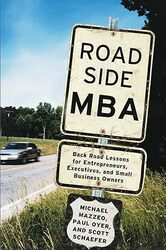
Rating: 8.0/10.
Roadside MBA: Back Road Lessons for Entrepreneurs, Executives and Small Business Owners by Michael Mazzeo, Paul Oyer, Scott Schaefer
Book where a trio of economists go on several road trips around the US to examine small businesses: their business models and strategies. This book showcases a lot of variety and is grouped into ten categories, each one with several case studies. While these case studies make for a quite entertaining read, the analysis is somewhat shallow, focusing just a page or two on each business before moving on to the next. Moreover, only one single factor is analyzed for each business without delving into any further complexities. The book also contains quite a lot of filler material, including the economists teasing each other during their road trips, which I found to be quite annoying and irrelevant.
Efficiencies of scale
- One store centralized a lot of operations that could be shared across locations, enabling each new location to be more efficient.
- For a rubber parts manufacturer, there is a high fixed cost associated with producing the mold. However, it’s relatively inexpensive to produce lots of the part. Therefore, they have to analyze whether the demand for the part is worth the investment.
- A coffee shop was where the owner had to personally oversee operations to ensure quality, making it hard to scale up. In contrast, a different restaurant was able to remotely monitor employees across different locations, making it easy to scale up.
Establishing barriers to entry
- A specialty store specializing in baby furniture was safe from competition because there was only enough market for one such store in the area.
- A business making fire hoses had a large sunk cost for entry, therefore deterring competitors from attempting to enter the market when the incumbent already put in the sunk cost.
- One recruitment service for accountants depended on having network effects, you needed to know both sides – accounting firms and new accounting graduates, so that was difficult to replicate.
Product Differentiation
- A gym specialized in fitness for women had features catering to this demographic, such as privacy for exercising away from public view.
- A bank in Montana specialized in high-value businesses: small businesses with large amounts of deposits. Thus, they purposefully made their offerings less appealing to low-value clients, eg, by not providing good retail services.
- A manufacturer of titanium wheelchairs was more expensive than the competition. However, they customized the wheelchairs to fit the user’s body, providing enough value to justify the cost.
Setting Prices
- A tool-making company bids on contracts to manufacture specialized tools for factories, it’s vital that they precisely understand their costs to avoid accidentally winning a bid due to underestimating the cost (this is also known as the winner’s curse).
- A dog daycare uses a clever marketing strategy to discriminate prices between customers who would pay more vs less: they only send coupons to clients who are located far away from them, because the service is less valuable to them.
- A music instrument rental shop found opportunities to bundle insurance and financing instruments, in order to increase the willingness of customers to buy.
Branding
- Brand recognition or reputation is particularly significant for certain goods where it’s hard to judge the quality until after buying. For instance, a school for actors relies heavily on their name and reputation, when locals are not knowledgeable about the acting industry.
- For certain services such as funeral services, buyers often select the first option they find, so it’s important to get your brand into the minds of consumers, ensuring that you are the first thing they seek.
Negotiating Effectively
- A composting plant received biowaste from a municipal treatment plant, and the price they negotiated depended heavily on the best alternative options of both sides. Therefore, knowing your options is really important.
- A company designing security camera systems for Walmart, but they are notoriously tough on suppliers, so the company took on related tasks to make themselves harder to replace.
- The hold-up problem ups occurs when one party must make a significant commitment to enter a relationship, which makes it likely that the other party could take advantage. Therefore, they must agree on a long-term contract before starting the project.
- A recycling company for catalytic converters used data analytics and algorithms to determine more precisely the worth of a load, enabling them to price it more accurately.
- A small machine shop found it difficult to find foundries willing to work with them, so instead of negotiating, they decided to start their own foundry.
Hiring
- A bowling alley screens applicants who are most driven to work there by only accepting applications done in person, not online.
- A services company specializing in verifying admissions materials for universities, must hire employees of a higher quality than typical call center employees, so they pay more than the minimum wage and understand the optimal price versus quality trade-off.
- A shop sewing industrial fabrics, they structure their compensation based on the number of items sewn that pass quality control, ensuring, that only applicants who can work quickly and accurately will apply for the job.
- A distribution company decided not to run any night shifts because it found that employees who prefer this shift are typically of lower quality.
Incentives for employees
- A company paying for transcriptionists must carefully balance between quality and quantity during transcriptions: paying by word incentivizes speedy but sloppy work.
- Salespeople are typically paid by commission, which means they earn a proportion of the revenue they bring in, rather than the profit, this is because the profit is often based on factors like cost, over which they have no control. However, an estimator (who decides on the cost of a job) is paid on the profit since they oversee both the price and the cost. It is important to align incentives with what the employee can control.
- An auto repair shop found that paying employees based on performance metrics resulted in them selling unnecessary repairs to the customer, so it was better to simply pay them hourly.
Delegation
- A series of factory plants must be geographically dispersed, not concentrated, due to transportation costs, so the boss wants each factory manager to make decisions autonomously – ideally, they should make the same decisions that the boss would have made in the same situation. This is why they tie their compensation to the plant-level profits.
- Tying performance to accounting measures is problematic though, because they tend to be short-term focused, eg: an ice cream shop realized that the managers would use smaller scoops to reduce costs in the short term, but this resulted in customers not returning.
- Often it’s quite tricky to coordinate the incentives of different parts of an organization, eg: conflict may arise if different parts of the company compete with each other for a limited slice of the profits, or if the sales organization sells so much that the engineering organization cannot handle it.
Competing with the big players
- A bookstore realizes that it cannot compete on price with the larger national chains, so they specialize in curating the books and ensuring there is a diverse collection available for customers, and being knowledgeable enough to make recommendations.
- A small engineering product company has the advantage of being small enough so that their salespeople are closely tied with the engineering department. In big companies, the sales and engineering departments are siloed and don’t communicate with each other, making communication is much more difficult.
- A marketing company prices its products at a lower range than a large agency, catering to businesses that require marketing on a smaller scale.
- A billboard company and a sporting goods company each use local knowledge to their advantage, specifically when it comes to knowing which local sports team’s shirt colors are popular and what type of customers frequent which locations in town, a level of localized information which larger companies often lack.



